10 Awesome, NON-D&D RPGs Your Collection NEEDS
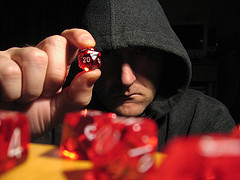 |
| Qfamily |
| Overthrow your (Dungeon) Master! Not every game needs a D20. |
As con season approaches with the all-time title bout between Pathfinder and D&D Next in its wake, it seems like a time to step back a little. Let’s remind ourselves of the smaller, weirder aspects of RPG fandom. Although publishers willing to commission a large-scale print run are diminishing, the tools available today can more than make up for it. Crowd funding, PDF, POD options – not to mention Amazon and eBay – make it so the obscure titles aren’t as obscure as they used to be; most are little more than a Google search away. Although we’ve put together only a taste of what’s available in the market today, here is a sample of ten that might catch your interest.
1. After The Bomb
 |
| Don’t let Michael Bay know about this one. |
After the Bomb was originally a licensed Teenage Mutant Ninja Turtles RPG product but when Palladium Books lost the license they made it more of a generic apocalyptic game. Either way, it was a lot of fun. You also have the side benefit of all of Palladium’s books following generally the same system, thus allowing your character to sidestep into other settings. True story; my favorite character ever was an anthropomorphic T-rex from T.M.N.T. dropped into Palladium’s kitchen sink RIFTS setting. He liked to eat the limbs of underlings that displeased him. Good times.
For all that, the Palladium system can be a bit of a nightmarish labyrinth of warmed over 1980s-era game design, though I’ve always thought they handled martial arts well. Having characters with varying number of attacks per round, everyone getting a defense roll, tons of situational modifiers, and everyone having enough hit points to suck up 10+ hits are all obstacles in a gunfight. But in a protracted martial arts duel, they are pretty much on topic and help build atmosphere. Also the Palladium system has stats for “roll with blow” and “backflip”. I think that seals the deal.
2. Spirit of the Century
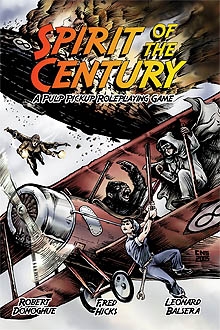 |
| Evil Hat Productions |
| Biplanes, gorillas, dames in distress, what more could you want? Grab your fedoras, gentlemen. |
Fate‘s successful Kickstarter last year has made them a very popular generic RPG from Evil Hat Productions with many settings here or on the way. However, before Evil Hat’s ascension, there was a time when their main RPG was Spirit of the Century. A pulp-based setting with survivors of World War I out to Save the World, its ease of use and casual blending of magic and advanced tech earned it a special place in my heart. You play 1920s-ish adventurers organized into a Century Club. Not-Tarzan, not-Shadow, not-Rocketeer, and not-Houdini characters are encouraged and just scratching the surface of the available archetypes.
The best news, though, is that Fate has not forgotten Spirit of the Century in its new era. One of the first books released for Fate Core was The Day After Ragnarok, a book that is effectively a sequel to Spirit of the Century. Basically, Hitler starts Ragnarok and the heroes of Spirit of the Century manage to kill the Midgard Serpent by having not-Rocketeer fly a nuke into its mouth. The remnants and survivors of the Century Club are now released into a post-Ragnarok Cold War world where you’re equally likely to be menaced by nazis, commies, and frost giants. Sounds like a fun Saturday night!
3. Blue Rose
 |
| Paul van de Velde |
| It’s like this, in RPG form. |
Blue Rose is one of the more successful iterations of the once genre-crushing D20 system. When D&D Third Edition was first released, the powers that be decided its core system should be freely licensed to basically anyone who was interested. This somewhat quixotic decision did result in the D20 System being adopted or at least acknowledged by almost every RPG release of its time, but being as the license was free, it really didn’t directly benefit the brand owners at all. Although it possibly spurred on sales of the core books, I doubt we’ll see such an altruistic move by a game publisher again.
Blue Rose‘s version was called the True20 system and it was liked well enough to spin off into its own line. System issues aside, the reason why Blue Rose is interesting is that it was an attempt to grab the ‘other’ side of fantasy gaming; the side with romances, semi-relevant religions, and conflicts that didn’t always get resolved by rolling for initiative and then cutting each other until one person falls down. Can you do a high, romantic fantasy with the same basic engine as hack and slash D&D? Well, I think it’s debatable, but I’ve enjoyed the games I have played and I really, really appreciate that Blue Rose is something a little different from the default.
4. Abney Park’s Airship Pirates RPG
 |
| Myke Amend/Abney Park |
| Be a terror of the skies but a danger to yourselves. |
If I invited you to play an RPG based on a steampunk band, I’m not sure how you would react. RPGs are obscure. Steampunk is at least semi-obscure and steampunk music is definitely obscure. Plus the era of “band goes on real life adventure” shows seem to have greatly diminished from its heyday of the Chipmunks, KISS, Josie and the Pussycats, JabberJaw, etc. So what are the odds of a band RPG being any good? (Although they are making a Jem movie, so maybe that genre is making a comeback.)
As it turns out, Abney Park’s Airship Pirates RPG is actually a lot of fun. “Captain” Robert Brown, founder of the band, is actually into geeky things and has a large amount of involvement with the occasional spin off. It helps that Abney Park’s music is less about an idealized Victorian era and more about a weird post apocalypse where everyone lives in the sky to avoid genetically-modified monsters that roam the land looking to kill people. The background story, in which the band gets a time-traveling ship and goes through history righting wrongs only to accidentally set up the most evil dictator ever, is wacky but not particularly overshadowing current events. The game also has surprisingly good rules for crewing a flying ship, creepy automaton-people, and a good variety of character backgrounds and tweaks to choose from.
5. Savage Worlds
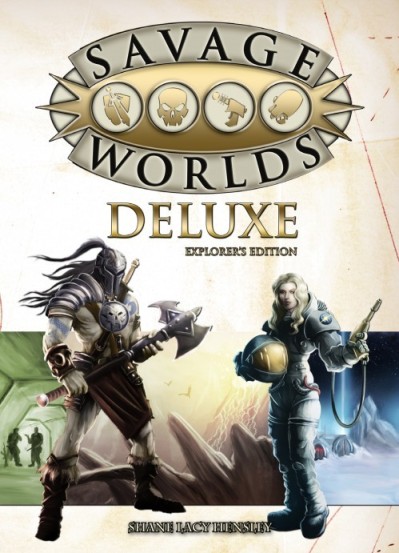 |
| PEG |
Billed as fast, furious, and fun, Savage Worlds trades out much of the book-keeping of more complicated games to bring you a slim $10 full-color rule book. I don’t know how much you know about RPG pricing but you can trust me when I say it’s practically free as I am very trustworthy due to writing things on the Internet. The Savage Worlds rules are simple, so simple that it’s pretty easy to convert almost anything to Savage Worlds as you only have a few things to worry about.
I have played games using the Savage Worlds rules a few times, and combat always kept moving, which was nice, as the more tactical RPGs can bog down here and there. A typical session covers a week in the first three hours and the last hour covers 5 minutes of combat. There are times where I do miss some of the meatier bits of combat (I generally lean towards the more intensive math / details in combat, personally) but there are some innovative bits to the system that keep things interesting. My favorite is exploding dice, which basically mean once you roll the highest on a die you get to roll it again, and if you hit max then you roll it again, on and on until your luck rolls out. Generally this has no impact on a session but once in a while the results are hilarious and memorable.
6. GURPS
 |
| See-ming Lee |
| GURPs is the building blocks, you build the colorful people. |
The Generic Universal Role Playing System is the “evil twin” of Savage Worlds, emphasizing detail and nuances over ease of play. If you want to convert an alien or monster to GURPS then you will find rules for all of the weird stuff that sometimes gets lost in translation. Often in a gaming session you will hear people call out things like “Shouldn’t I be immune to that? I’m a half-Orc and the book says they enjoy pain.” Or “My character’s a war vet, so clearly he would know that they set up an ambush.” Then if you’re running the game, you have to decide. Do you reward creativity? Or are the arguers skewing the game in their favor by being good at arguing and making connections?
GURPS avoids this by having rules for everything. Sure, your vampire drinks blood and runs fast, but can she disappear in the shadows? Is she allergic to garlic or flinch when she sees a crucifix? Maybe she returns from any death but decapitation. There are rules for all of this, with positive traits having a point cost and negative traits refunding points. The thing I like best about GURPS is that it pushes you to think deeper. Are vampires fertile? Can they withstand cold? Poison? Can they smell blood a block away or see in the dark? As long as you have time and energy you can make exactly what you want in GURPS.
7. The Queen’s Cavaliers
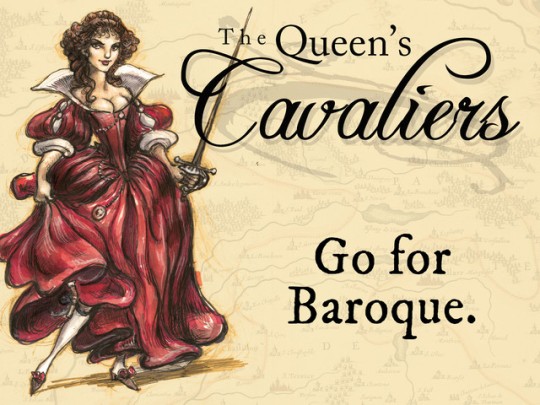 |
| Caoimhe Ora Snow |
| Because if it ain’t baroque… |
I don’t own this game as The Queen’s Cavaliers Kickstarter just went live, but they have been play testing at the local L.A. gaming cons for a few years now. This game has a somewhat narrow focus: a mildly magical and mildly anachronistic take on France-like nation full of swashbuckling and high adventure. In theory almost any RPG can handle something like this, but what I like about Queen’s Cavaliers is the fact that the system has been built from the ground up with one particular genre in mind. I think that this leads to a much deeper experience as instead of playing a little side-game within the main game, as swashbuckling tends to be treated in RPGs.
Basically, the game uses a system wherein successes rolled in combat can be spent in various ways, with damaging your opponent only being one option (actually two options, as non-lethal damage is already available). You can use successes to charge up style points or advantage dice, which instead of immediately being used on an opponent can be used later for a big spectacular attack. This gives you a good reason to engage an opponent for a few rounds before devastatingly counter-attacking. Seems like a good way to capture the feeling of fencing without those crazy metal helmets and those weird white suits.
8. Warhammer 40K Roleplay
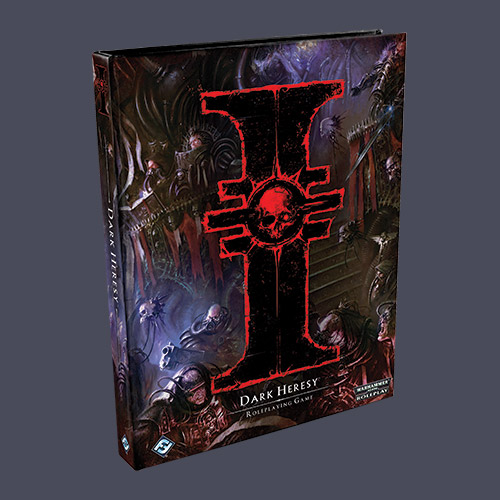 |
| Fantasy Flight Games |
| RPG or cover of an awesome new metal album? |
You may, at some point in your life, find yourself at a convention where people are playing Warhammer 40K. This will involve tables full of large miniatures, a majority of which are tiny men in armor. That isn’t the game I’m thinking of, though. Warhammer 40K also has a sizeable RPG line, full of beautiful art and tongue-in-cheek prose that keeps thing rolling. Titles include Dark Heresy, Rogue Trader, Deathwatch, and more, although they all take place in the same setting. The world of Warhammer 40K is well summarized be the somewhat infamous quote: “In the grim darkness of the future, there is only war.” Basically, the messiah arrived a few thousand years back, built the perfect society, leading humanity towards a golden age, but then he fell in battle. Then humanity tied his consciousness to his rotting corpse and used it to make a big beacon for people to travel through space. It’s been a long time since then and things are really awful.
Warhammer‘s spaceships are massive, floating monstrosities that tend to be centuries old, if not older, since it’s pretty difficult to find a shipbuilder these days. They’re full of hundreds of people who live and grow old there on the ship, each performing some tiny duty that they barely understand. They actually have it good, though, since most people are starving or being eaten by monsters at any given minute. Not that the ship crew themselves are entirely safe, as most ships contain abandoned decks and levels that eventually fill up with savage cannibalistic descendants of lost crew, if not something worse. In summary, Warhammer 40K would be depressing to play in if it weren’t so very depressing that it switches around to actually being quite funny in its own right.
9. Maid, the RPG
 |
| Star Line Publishing |
| That about sums it up. |
Full disclosure: I haven’t played Maid the RPG. I bought the book on a whim after hearing some whispers of its existence, and I’ve read through it, but no games yet. Given the somewhat-objectionable nature of some of the things in this book, I imagine I may never get a game together and even if I did, it might be uncomfortable. Still, the strangeness and perversity of this game makes it impossible for me to leave it out of this list. What other games let you start with a gimp as equipment? Has an optional effect called “I Peed A Little”? Or has Nymphomaniac, Sadist, Masochist, Womanizer, Exhibitionist, and… uh, “Likes them Young” as special qualities?
The core idea of the game is that you play anime maids trying to please and get closer to a somewhat-mysterious “Master”. Ways to do this include accidentally getting undressed in front of the Master, accidentally kissing the Master, and “forcibly seducing” the maid to your right (not sure how this helps; I haven’t played it). You can also wear battlesuits, ride motorcycles, go into outer space, kill your parents, be kidnapped, be a former prostitute, be a cyborg, have a “World-Rending Grudge Sword”, or learn a “World-Changing Song”. This just barely scratches the surface of the weird stuff in here; in an RPG imported from Japan. An RPG imported from Japan has to be good, right?
10. Wield
Another Kickstarter game I have play tested, John Wick’s Wield starts out as a fairly standard fantasy world. Heroes find magic weapons, and the weapons have strong personalities and goals of their own. Both the weapons and the heroes grow in power and legend over time. This is all stuff you can do with almost any version of D&D. However, Wield has one big twist up its sleeve. Instead of playing the heroes, you play the weapons. You dole out powers to your hero as you see fit, allowing them to win battles but also giving them more control over you.
The group actually splits the roles; each player plays both a weapon and the wielder of another weapon. The players adventure together, but the weapons often have long and sometimes bitter histories with each other as they are essentially immortal. In the game we played, I was a barmaid who wished to be the greatest hero in the world. She was trapped with a “Cup of Water and Healing” that had basically no combat abilities whatsoever. The only solution, of course, was to use the invincible (and large) cup as a mace. This made the pacifistic cup very unhappy, resulting in the cup trying to kill the barmaid. Such shenanigans are the basis of a Wield game, and they are both unique and hilarious.
Previously by David N. Scott
10 Reasons You Should Be Watching NBC’s Hannibal (Really!)
Eight Reasons You Should Care About the World of Darkness Reboots
Ten Things We Learned Attending L.A. By Night: The Grey Ghost Masquerade
10 Things Learned Shopping for a PS4 on Black Friday (At Midnight)
